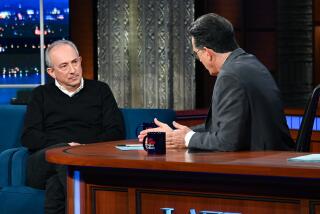Reps Make Longaberger Memoir a Bestseller
- Share via
A Newark, Ohio-based company that last year sold $1 billion worth of wooden baskets and other decorative items is pitching a new product: a posthumous memoir by its founder that unexpectedly has hit No. 13 on the New York Times bestseller list.
The book, describing the life and business philosophy of company founder Dave Longaberger, appeared on the closely watched list even before the title was generally available through bookstores and online sites.
The flood of early orders occurred after the company “encouraged” 70,000 independent sales contractors to buy the book.
The surge in sales of “Longaberger: An American Success Story” surprised executives at HarperBusiness, a division of New York-based HarperCollins, which earlier this month increased its planned press run to 100,000 from about 25,000.
“We thought there was a pretty good chance it could translate into sales,” said Editor in Chief Adrian Zackheim. “But I’ll be quite honest . . . we didn’t ever anticipate that it would grow to be this size.”
The book’s appearance on the list was based on sales during the week ended March 3. But it also prompted a cautionary note that “some bookstores report receiving bulk orders.”
That note often signals the existence of an organized effort to drive sales of an otherwise undistinguished book.
Longaberger executives denied any attempt at manipulating the bestseller list. “That’s truly not the intent at all,” said Julie Moorehead, Longaberger’s director of communications. “Our goal was purely to share Dave’s story with as many people as possible. Being on the bestseller list is a wonderful side benefit, but we make baskets, not books.”
Zackheim said the book appears to have caught the eye of Longaberger consumers who are interested in the founder’s home-spun success story. “It’s clear to me that [Longaberger] is putting the book in front of real, live customers.”
Publishers say sales of books with business-related titles can vary dramatically. During the 1990s, for example, HarperBusiness sold about 200,000 copies of a book written by Hewlett-Packard co-founder David Packard. In contrast, an earlier book written by Dave Longaberger and published by another company in 1991 had a total press run of just 3,500 books.
Moorehead said the company hopes to build sales by using its built-in marketing force. “We are a direct-sales company with 70,000 sales associates,” Moorehead said. “What better way can there be to promote the book than to harness the excitement and enthusiasm of our sales associates?”
Longaberger’s direct-marketing machinery also is pitching the book to 185,000 Longaberger collectors and millions of others who have purchased the company’s baskets, pottery and wrought-iron items.
HarperBusiness is waiting to see how many more books will be sold by the efforts of Longaberger sales reps who push baskets much the same way Avon Products Inc. and Tupperware Corp. market beauty and food storage products.
Longaberger has outfitted the reps with book promotion kits that include buttons, displays featuring the book’s cover and other materials.
The nationwide effort includes in-home sales parties and an estimated 2,400 advertising displays that sales representatives have erected in libraries and bookstores to promote the book. Zackheim described the marketing push as being fueled by “an incredible amount of passion.”
Longaberger is pushing sales reps and customers to buy the book, but the company isn’t selling the memoir. Instead, it steers customers to bookstores and online stores.
In the book, Longaberger describes “growing up poor in a family of 14” and the road to serving as chairman of a company that now has 8,000 full-time employees and $1 billion in revenue.
*
BASKET CASES
For some collectors, Longabergers are the adult’s Beanie Babies. E2
More to Read
Sign up for our Book Club newsletter
Get the latest news, events and more from the Los Angeles Times Book Club, and help us get L.A. reading and talking.
You may occasionally receive promotional content from the Los Angeles Times.









